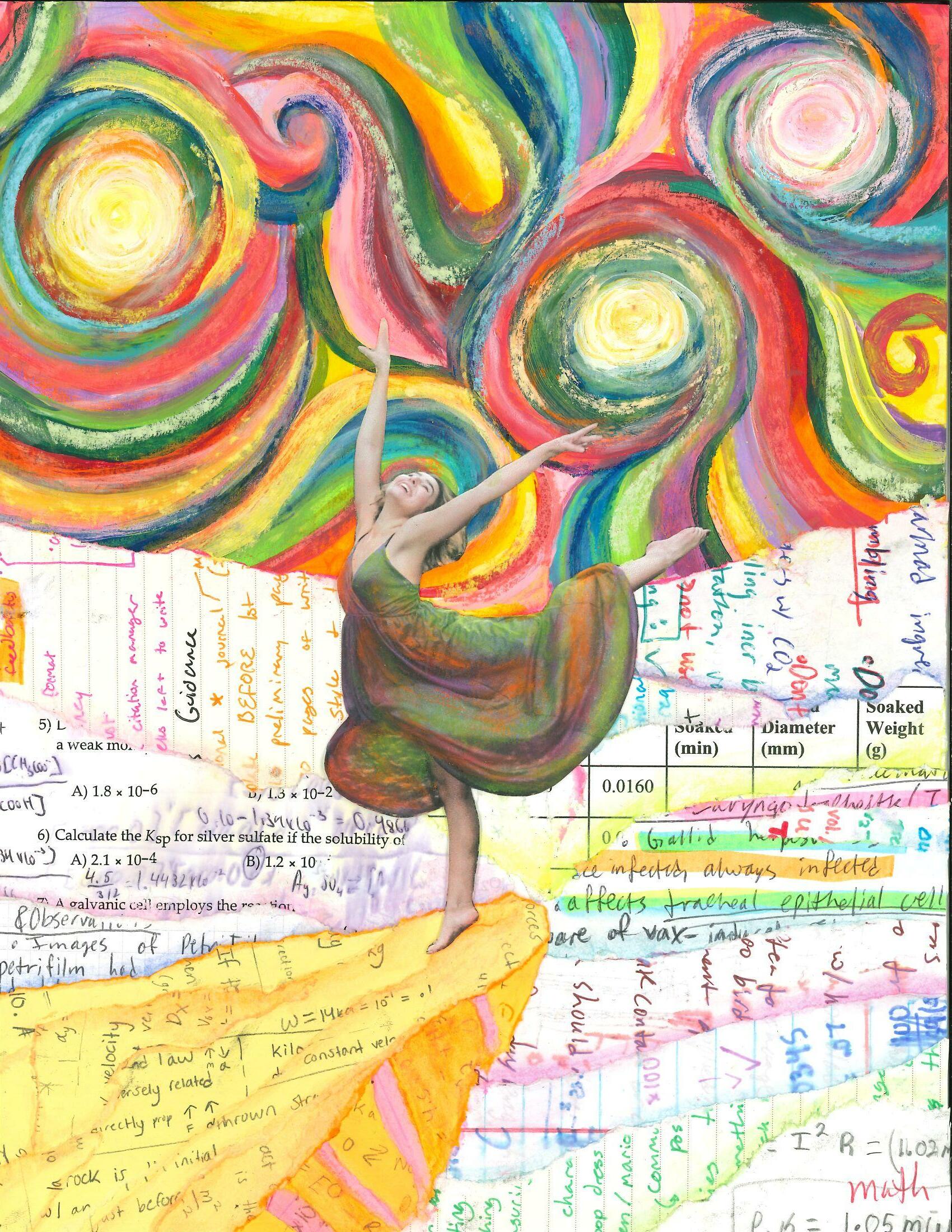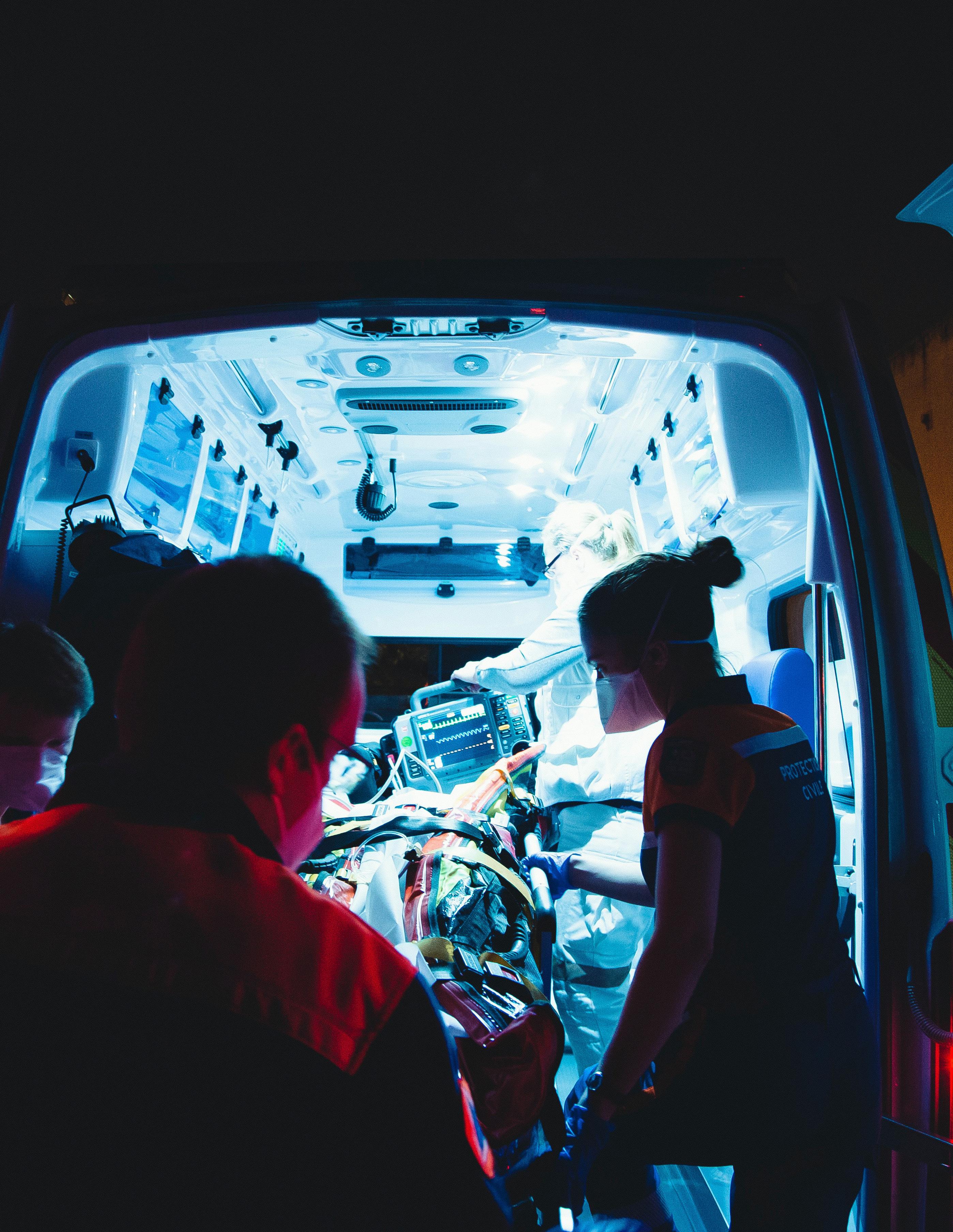
19 minute read
ACCELERATING TRAINING THROUGH PERSONALIZATION IN AUGMENTED REALITY
By Isabella C. Pedron ‘23, Connor M. Barnes ‘23, Ashley E. Bailly ‘23
INTRODUCTION
Advertisement
The U.S. Emergency Medical Services (EMS), composed of first responders, emergency medical technicians (EMTs), paramedics, firefighters, and others, is a vital system that provides urgent prehospital treatment and transport. These emergency response (ER) workers attend to over 42.5 million calls every year.1 However, career burnout and relatively low salaries have led to a significantly high annual turnover rate of 20–30%, with estimated turnover costs being $6,400 and $7,700 per full-time EMT and paramedic, respectively.2 In recent years, these issues have caused an acute nationwide shortage of ER workers, causing slower response times, a lack of services, and a deficit of supplies in many areas. The ongoing COVID-19 pandemic has caused the ER worker shortage to reach a crisis level. ER training programs were paused or shut down entirely, the National Registry of EMTs stopped its certification testing, and hospitals short on nursing staff began to hire paramedics at higher wages. These workforce shifts occurred at a time when the nation saw an unprecedented increase in EMS call volumes.3 There is a pressing need to expedite the training of ER workers while maintaining high quality of instruction.
To address this need, we collaborated with several other universities and public safety partners to develop an adaptive EMS training platform called LEARNER. LEARNER integrates modern human augmentation technologies such as robotics, virtual reality (VR), and augmented reality (AR), to improve work conditions of EMS personnel as well as provide immersive and accessible modalities of training. Our goal is to accelerate expertise development by implementing an innovative approach for EMS-based curriculums by tailoring training to individual program and trainee needs. Our latest study focuses on using AR as a training delivery method.
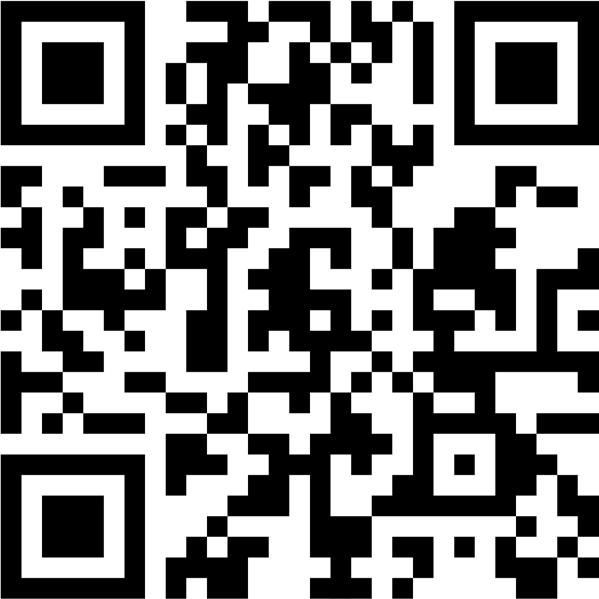
Scan the QR code to watch the LEARNER project video created by the NeuroErgonomics Lab, or visit https://tx.ag/509LEARNERvideo.
AR technology superimposes virtual objects on the real world. Blending real and virtual content offers unique benefits over other training methods by creating more immersive and realistic learning experiences. Other benefits of AR include the ability to program a wide variety of customized scenarios for training and its high level of portability, as it only requires a head mounted device or a smartphone with an AR application.4 These features enable greater levels of personalization and allow for situational learning that fits the user’s needs, which have been shown to make the learning process easier and faster. In fact, AR-based training is already used in a variety of medical applications, such as surgical training, and has reduced the amount of time needed to practice certain skills.5 Even so, there is little empirical evidence regarding the effectiveness of this emerging technology.
In a previous study conducted by our lab, we compared the efficacy of AR-based training to video-based training, a more conventional training method. We analyzed how first-time AR users learned how to interact with the AR interface in different training
modalities by evaluating parameters that affected performance during training and retention. We found that AR-based training resulted in better immersion and higher user engagement; however, it was associated with greater frustration, lower focused attention, and higher cognitive load.
Building upon the aforementioned research, this current study aims to: 1) evaluate a machine learning algorithm designed to advance the development of a personalized training program while taking into consideration the drawbacks of AR-based training previously found; and 2) examine differences in subjective, physiological, and performance metrics between high and low performers.
METHODS
Participants
We recruited 12 participants (50% females) for our study with a mean age of 21±1 years. Recruitment was limited to right-handed individuals with less than one hour of AR/VR experience. These requirements ensured that all participants used the same, dominant hand for the duration of the study and began with the same limited knowledge of immersive, interactive environments. For safety reasons, additional exclusion criteria included an allergy to adhesives, a history of photosensitive epilepsy or seizures, and a metal implant or other device in the head. Participants were compensated for their time. This research was approved by the Institutional Review Board (IRB2021-0742DCR).
Study Protocol
Each AR session was completed in one day, lasting about two and a half hours. The study had four phases: setup, AR familiarization, AR adaptation (if needed), and evaluation. Figure 1 summarizes the study protocol.
At the beginning of each session, participants were outfitted with an Actiheart device (Actiheart 4, CamNTech, Inc., UK) to collect heart rate data, an Empatica watch (Empatica E4, Empatica Inc., USA) to collect electrodermal activity data, and an AR headset (Microsoft HoloLens 2). We collected initial subjective surveys and baseline data for three minutes prior to AR training.
During familiarization, participants learned four AR interaction tasks: 1) poking, 2) raycasting, 3) scrolling, and 4) moving. The order of tasks was varied to reduce order bias. Participants trained on the four tasks by completing six trials for each task. After each task, subjective surveys were collected regarding the participant’s experience. Figure 2 showcases these tasks in AR via video.
1. Poking involved pointer finger selection and was utilized when the virtual elements were
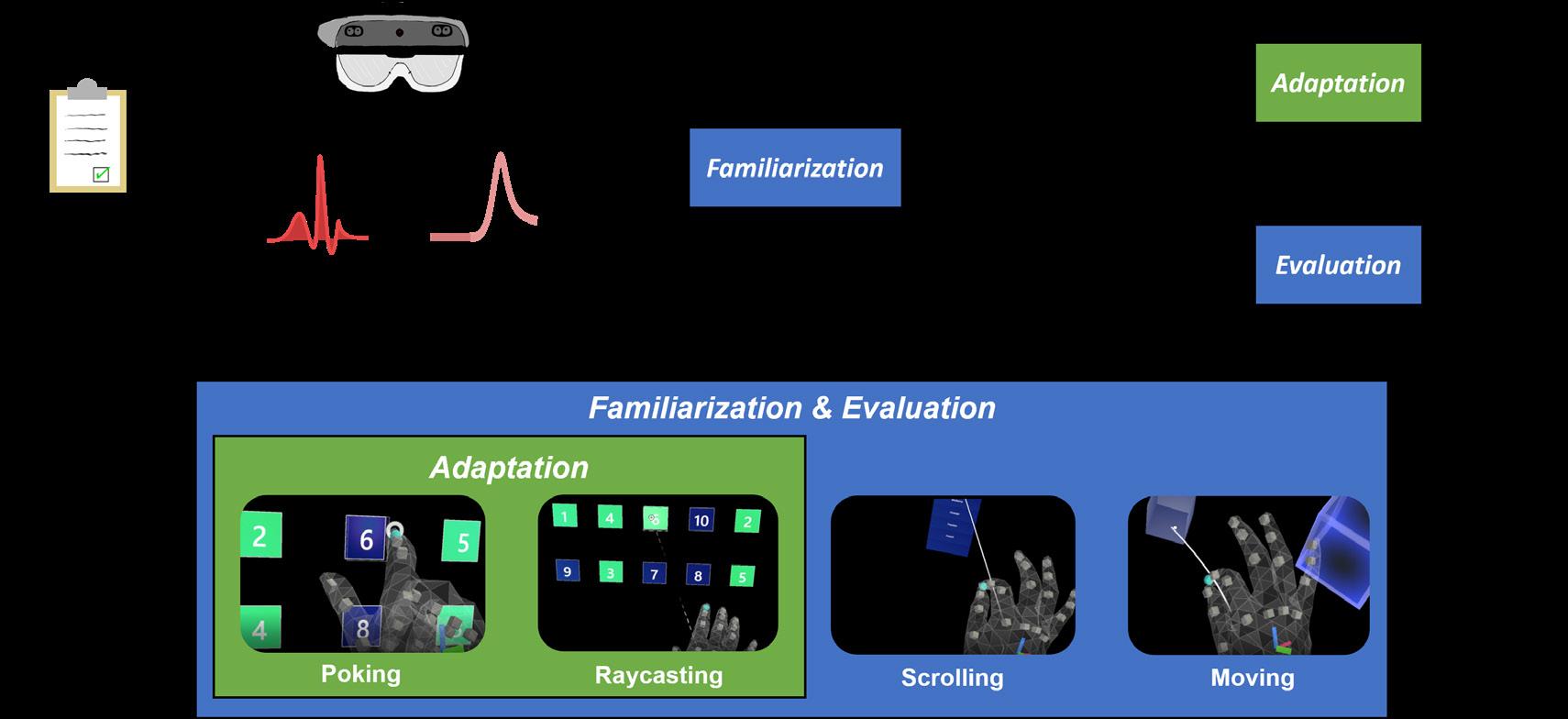
within arm’s reach of the user. The user was instructed to select the numbers one through ten in ascending order.
2. Raycasting was utilized when the virtual elements were out of arm’s reach of the user. This selection method required the user to direct a beam of light from their palm and then select elements by pinching their pointer finger and thumb together. The user was again instructed to select the numbers one through ten in ascending order.
3. Scrolling involved scrolling through a list, requiring the user to direct a beam of light from their palm, grab elements by pinching their pointer finger and thumb together, and scroll up or down by moving their hand vertically.
During this task, the user selected a certain word from a menu.
4. Moving involved moving an object from one location to another. The user performed this by pinching their pointer finger and thumb together, moving their hand horizontally, and then releasing their fingers.
Next, the participant’s AR interaction data was run through our machine learning algorithm to determine whether adaptation (extra practice) was needed. Only poking and raycasting were considered for adaptation as raycasting was a prerequisite to perform scrolling and moving. If the machine learning algorithm deemed extra practice was needed for poking and/or raycasting, the participant would undergo additional training by completing three more trials for the task(s).
Lastly, the evaluation phase gauged the participant’s success at learning the AR tasks by repeating all four tasks again for three trials each.
Adaptation Model
We analyzed two metrics from twenty-seven participants from our prior study as measures of performance and consistency, respectively: 1) total median time6 and 2) root mean square error (RMSE), a measure of distance from a prediction.7 Total median time was calculated by taking the median of the overall time required for each trial and adding all the median values. RMSE was calculated by fitting a 2-degree polynomial over the learning curve comprising performance and number of trials, as seen in Figure 3. We used k-means clustering with two clusters of high and low performers, as portrayed in Figure 4. Low performers were designated as those who had a higher median time and RMSE. New participant data points were excluded from the original dataset to prevent changes in the cluster centroid coordinates. The new participant data was compared to these high and low performer centroid coordinates to determine if adaptation was needed.

Figure 2. Video of the four augmented reality tasks: poking, raycasting, scrolling, and moving. Scan the QR code to watch the Figure 2 video, or visit https://tx.ag/509Fig2.
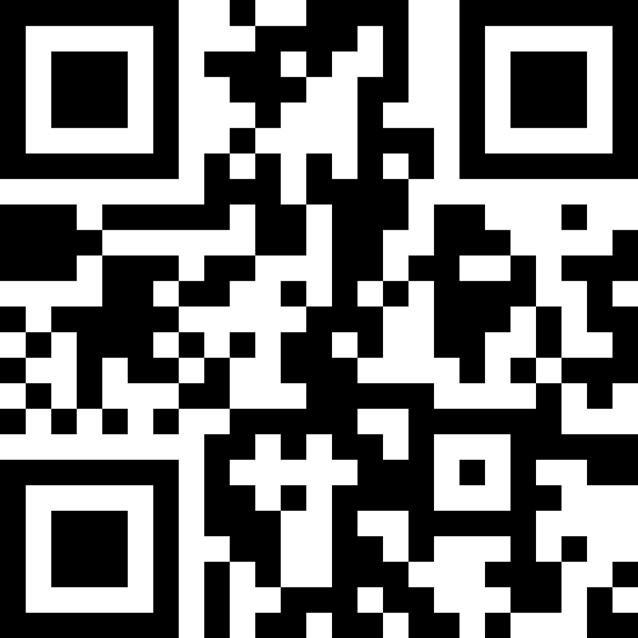

Figure 3. Plot of median time and trials for RMSE of a skill.
Figure 4. Plot of performance vs. consistency of a skill. affected by the interactivity and complexity of tasks. For these reasons, intrinsic and extraneous loads are useful metrics in this study.9 To assess the cognitive loads of participants, a standard CLT questionnaire was administered after each task. Each measure of CLT is on a one to seven scale, where seven represents a high cognitive load. An additional question asked each participant if they believed they needed more practice to obtain each new skill.

Physiological Measures
Electrocardiogram (ECG) and electrodermal activity (EDA) physiological parameters were measured as part of quantifying cognitive load. Research has shown ECG signals to be an important cognitive load indicator by analyzing heart rate (HR)10 and heart rate variability (HRV).11 A higher cognitive load causes the heart to beat faster.12 HRV is a quantitative marker for autonomic nervous system activity by describing the fluctuation in time between consecutive heartbeats. Two HRV features are commonly extracted to detect variations in cognitive load. The root mean square of successive differences (RMSSD) reflects the beat-to-beat variance in HR, and a higher cognitive load results in a lower difference.13 The low-to-high frequency ratio (LF/HF) is calculated using LF and HF measures which reflect stress and recovery, respectively, and a higher cognitive load results in a higher ratio.14
Measurements
Subjective Measures
According to Cognitive Load Theory (CLT), an individual’s performance is limited by the capacity of their working memory. CLT subdivides different loads into three categories: intrinsic, germane, and extraneous. Intrinsic is associated with the specific task, germane refers to the construction of long-term memories, and extrinsic is based on how the task is presented.8 Germane cognitive load is independent of materials presented, but intrinsic and extraneous are directly EDA, the measure of skin electrical conductance or sweat gland activity, has also commonly been used as a method for determining cognitive load.15 EDA is divided into two phenomena: 1) a tonic component defined as electrodermal level which represents slow-changing, general characteristics of the signal and 2) a phasic component defined as electrodermal response which represents faster-changing elements, including responses from specific stimuli.16 Due to the nature of the signal, the sampling rate and duration of data collection are vital to consider during experimental design; however, both served as limitations during
analysis.
Statistical Analysis
Analysis of Variance (ANOVA) is a tool used in statistics to determine if experimental results are significantly different from a control or between groups. The probability value (p-value) represents the probability of the occurrence of a value at least as extreme assuming that there is no real difference. The lower the p-value, the more significant a result is. Thus, a series of two-way ANOVA tests were performed to determine the impact of the study phases and need for adaptation on the subjective, physiological, and performance measures. The criteria used to find the statistical main effect of the dependent variable on the independent variable was a p-value < 0.05.
RESULTS
Only poking and raycasting were analyzed since these were the only tasks considered for adaptation. Physiological data was normalized to the participant’s baseline data to rule out individual differences. To evaluate the effectiveness of the adaptation model, participants were divided into two groups: low performers who needed adaptation (n = 7) and high performers who did not need adaptation (n = 5). Analysis was also performed across the phases of familiarization and evaluation.
Subjective Measures
For poking, no significant differences were found between groups or phases in either extraneous or intrinsic loads. For raycasting, there was no significant difference found between groups in intrinsic or extraneous load. However, intrinsic load showed a significant difference between phases (p = 0.047) and extraneous load showed a significant difference between the two phases (p = 0.016). In other words, lower cognitive loads were reported between familiarization and evaluation for the raycasting task.
Furthermore, although extra training for each participant was determined by clustering with high and low performers, each participant was asked if they believed they needed more training to acquire the skill. From the survey, 70% of participants agreed with the model, 20% believed that they had acquired it, but the model determined that they needed more practice, and the remaining 10% answered they needed more practice, but the model determined they did not.
Physiological Responses
For poking, we found a statistically significant difference in HR by both the phase (p < 0.001) and group (p < 0.001), though the interaction between these terms was not significant. There were no statistically significant differences in RMSSD or LF/HF by either phase, group, or interaction between these terms; however, there was a trend toward significance in RMSSD by phase (p = 0.085).
For raycasting, there were no statistically significant differences in HR, RMSSD, or LF/HF by either phase, group, or interaction between these terms;
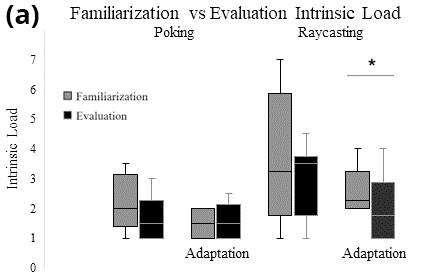
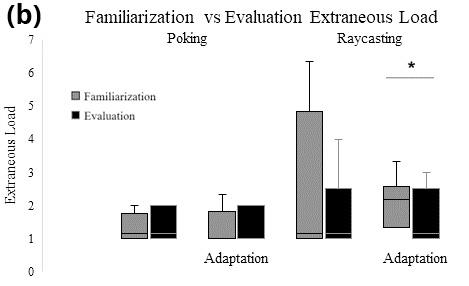
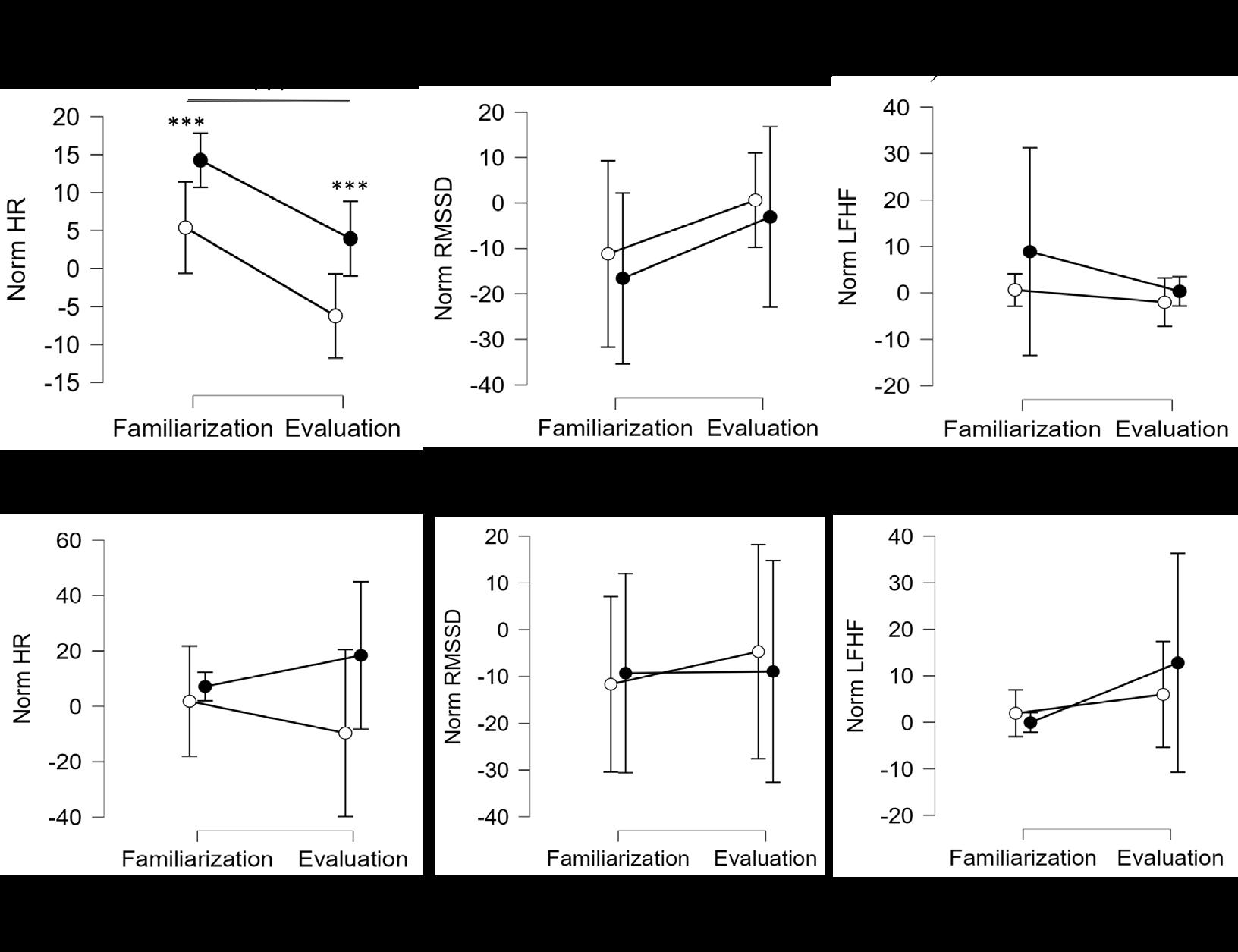
Figure 6. Normalized ECG for (a) poking and (b) raycasting tasks.
however, there was a borderline of significance in HR by group (p = 0.059).
While pre-processing the EDA data, initial analysis revealed that the quality of the obtained data was not adequate to determine viable results. For future studies, it should be noted that the sampling rate should be increased due to the temporal sensitivity of the data, and the length of recording time should be increased to obtain enough relevant data due to the slow measure nature of the signal.
Performance
For both poking and raycasting, we found a statistically significant difference in median time by both the phase (p = 0.029; p = 0.008) and group (p = 0.001; p < 0.001), though the interaction between these terms was not significant. When comparing median time from familiarization to evaluation, the low performers who required adaptation on poking and/or raycasting were on average 17.8% and 37% quicker, respectively. However, the high performers who did not receive extra practice on poking or raycasting were on average 10.2% and 16.21% quicker, respectively.
DISCUSSION
This study evaluated a machine learning algorithm method to personalize AR training and studied differences between high and low performers. Preliminary results show that intrinsic and extraneous loads are mainly unaffected by a participant’s performance categorization. The only significant difference in subjective cognitive load was in the adaptation group having a decreased load, both intrinsic and extraneous, in the raycasting task. This may mean that the adaptation protocol is able to reduce cognitive load in certain tasks, but not others. Furthermore, the protocol identified 30% of cases where an individual’s subjective judgment did not match the recommendation of the model. If the choice for further training was left up to the participants, 20% would be under-trained on the system and 10% would spend longer than necessary on
Figure 7. Performance for (a) poking and (b) raycasting tasks. their training. The ECG data suggests that low performers consistently sustained a higher cognitive load compared to high performers. For poking, participants who needed adaptation experienced a higher cognitive load compared to participants who did not need adaptation as seen from the significantly higher HR. This may be a consequence of fatigue from extra practice or the fact that the non-adaptation group consisted of high performers, as deemed by the machine learning algorithm. The raycasting task revealed unexpected results when analyzed by phases. The adaptation group generally experienced an increase in cognitive load between phases as seen from the trending increase in HR and increase in LF/HF. The overall performance indicates that the adaptation model was effective at personalizing training. Looking at familiarization, performance showed that the machine learning algorithm successfully predicted whether a user was a high or low performer. Furthermore, low performers improved their median time more than high performers after undergoing additional training, suggesting the extra practice protocol was productive. One limitation of this study was the small sample size. Statistical power is limited with small
sample sizes, so unsurprisingly many of the tests failed to show significance due to a high standard deviation. Another limitation was the extremely short time duration for the AR tasks due to the reduced number of trials. The reduced number of trials was done to minimize fatigue and optimize performance, but a consequence is that the physiological data may not be reliable to analyze as they are slow changing measures. The next steps should be to solidify our findings by conducting more studies, increasing the sampling rate, and analyzing other types of physiological data that also analyze cognitive load for a more multimodal approach. One example of this includes utilizing functional near-infrared spectroscopy (fNIRS) to map brain activity through light reflectance by oxygenated and deoxygenated hemoglobin. This analysis would showcase which areas of the brain are most active during certain AR training activities, allowing for another approach in quantifying cognitive load.
These findings will be important in the development of future adaptive training programs that will hinge on these foundational AR interactions. If our analysis can discern that user-tailored AR training is effective at reducing cognitive load and maximizing

performance, future AR training platforms could prove to decrease costs and increase productivity for emergency response training. With an improved method of training based in AR, the field of emergency medicine may be better able to curb the shortage of workers and better address the limitations of current training. In the end, this may mean a safer and more productive EMS workforce.
ACKNOWLEDGEMENTS
We would like to thank our professor Dr. Ranjana Mehta, our lab manager Lindsey Brenner, and our graduate student mentors John Hayes and John Kang for their guidance and mentorship. We would also like to thank the other members in the NeuroErgonomics Lab for the supportive community. The machine learning algorithm was developed by Shivangi Dwivedi and Shantanu Vyas from the NeuroErgonomics Lab. The AR interface application was developed by Dr. Joe Gabbard, Cassidy Nelson, and Kyle Tanous from Virginia Tech University. This study was part of the LEARNER project funded by the National Science Foundation (#2033592) and approved by the Institutional Review Board (IRB2021-0742DCR).
REFERENCES
1. “National EMS assessment describes current state of EMS in the
United States,” ems.gov, 2021, https://www. ems.gov/newsletter/fall2020/national_ems_assessment_describes_current_state_of_ems_in_ the_united_states.html.
2. “AAA/Avesta 2019 Ambulance Industry
Employee Turnover Study,” Avesta Systems,
Inc. and the American Ambulance Association,
July 2019, https://ambulance.org/wp-content/ uploads/2019/07/AAA-Avesta-2019-EMS-Employee-Turnover-Study-Final.pdf.
3. Alaa A. Amiry and Brian J. Maguire, “Emergency Medical Services (EMS) Calls During
COVID-19: Early Lessons Learned for
Systems Planning (A Narrative Review),” Dovepress Open Access Emergency Medicine 13, (September 2021): 407–14. http://doi. org/10.2147/OAEM.S324568.
4. Jennifer Herron, “Augmented Reality in
Medical Education and Training,” Journal of
Electronic Resources in Medical Libraries 13, no. 2 (May 2016): 51–55. https://doi.org/10.10 80/15424065.2016.1175987.
5. E. Z. Barsom, M. Graafland, and M. P. Schijven, “Systematic review on the effectiveness of augmented reality applications in medical training,” Surgical Endoscopy 30, (February 2016): 4174–83. https://doi.org/10.1007/ s00464-016-4800-6.
6. Katherine J. Sullivan, Shailesh S. Kantak, and Patricia A. Burtner, “Motor Learning in
Children: Feedback Effects on Skill Acquisition,” Physical Therapy 88, no. 6 (June 2008): 720–32. https://doi.org/10.2522/PTJ.20070196.
7. Jiejie Zhao, Bowen Du, Leilei Sun, Fuzhen
Zhuang, Weifeng Lv, and Hui Xiong, “Multiple relational attention network for multi-task learning,” Proceedings of the ACM SIGKDD
International Conference on Knowledge Discovery and Data Mining, (July 2019): 1123–31. https://doi.org/10.1145/3292500.3330861.
8. Paul A. Kirschner, “Cognitive Load Theory:
Implications of Cognitive Load Theory on the
Design of Learning,” Learning and Instruction 12, no. 1 (2002): 1–10. https://doi.org/10.1016/ s0959-4752(01)00014-7.
9. John Sweller, “Element Interactivity and
Intrinsic, Extraneous, and Germane Cognitive
Load,” Educational Psychology Review 22, no. 2 (2010): 123–38. https://doi.org/10.1007/ s10648-010-9128-5.
10. Burcu Cinaz, Roberto La Marca, Bert Arnrich, and Gerhard Tröster, “Monitoring of mental workload levels,” International Association for
Development of the Information Soc. Proceedings of the IADIS International Conference on e-Health, (University of Zurich, 2010), 189–
93. https://doi.org/10.5167/uzh-66793.
11. Ashley M. Hughes, Gabriella M. Hancock,
Shannon L. Marlow, Kimberly Stowers, and
Eduardo Salas, “Cardiac Measures of Cognitive
Workload: A Meta-Analysis,” Human Factors:
The Journal of Human Factors and Ergonomics Society 60, no. 3, (March 2019): 393–414. https://doi.org/10.1177/0018720819830553.
12. Kristen N. Cranford, Jessica M. Tiettmeyer,
Bryan C. Chuprinko, Sophia Jordan, and Nathaniel P. Grove, “Measuring Load on Working
Memory: The Use of Heart Rate as a Means of Measuring Chemistry Students’ Cognitive
Load,” Journal of Chemical Education 91, no. 5 (April 2014): 641–7. https://doi.org/10.1021/ ed400576n.
13. Xiaoli Fan, Chaoyi Zhao, Xin Zhang, Hong
Luo, and Wei Zhang, “Assessment of mental workload based on multi-physiological signals,” Technol Health Care 28, no. 1 (2020): 67–80. http://doi.org/10.3233/THC-209008.
14. Fan et al., “Assessment of mental workload,” 67–80.
15. William L. Romine, Noah L. Schroeder, Josephine Graft, Fan Yang, Reza Sadeghi, Mahdieh
Zabihimayvan, Dipesh Kadariya, and Tanvi
Banerjee, “Using Machine Learning to Train a Wearable Device for Measuring Students’
Cognitive Load during Problem-Solving
Activities Based on Electrodermal Activity,
Body Temperature, and Heart Rate: Development of a Cognitive Load Tracker for Both
Personal and Classroom Use.” Sensors (Basel) 20, no. 17 (September 2020): 4833. http://doi. org/10.3390/s20174833.
16. Braithwaite, Jason J., Derrick G. Watson,
Robert Jones, and Mickey Rowe. “A guide for analysing electrodermal activity (EDA) & skin conductance responses (SCRs) for psychological experiments.” Psychophysiology 49, no. 1 (2013): 1017-34.

ISABELLA C. PEDRON ‘23 CONNOR M. BARNES ‘23

Isabella Christina Pedron ‘23 is a chemical engineering major from Plano, Texas. Isabella has been a leader for the Texas A&M Emergency Care Team since Fall 2020 where she has gained extensive knowledge regarding emergency medicine. This inspired her involvement with LEARNER as she could envision the potential this project had to offer. Following graduation, Isabella aspires to become a physicianeer by pursuing an M.D. and M.S. in engineering. Connor Barnes '23 is an interdisciplinary engineering major with minors in math and the design and simulation of mechanical systems. Connor is from Dripping Springs, Texas and went to Lake Travis High School. Through research, Connor aims to advance the use of interactive technology in learning environments. After college, Connor plans to work on the utilization and improvement of rapid prototyping for manufacturing.
ASHLEY E. BAILLY ‘23

Ashley Bailly '23 is a biomedical engineering major from Houston, Texas. Ashley has been with the NeuroErgonomics research lab for two semesters as a member of the LEARNER team. She is in the Brown Engineering Honors program with plans to write an undergraduate thesis for LAUNCH. Following graduation, Ashley plans to pursue a M.S. in biomedical engineering and later join industry working in research and development.


